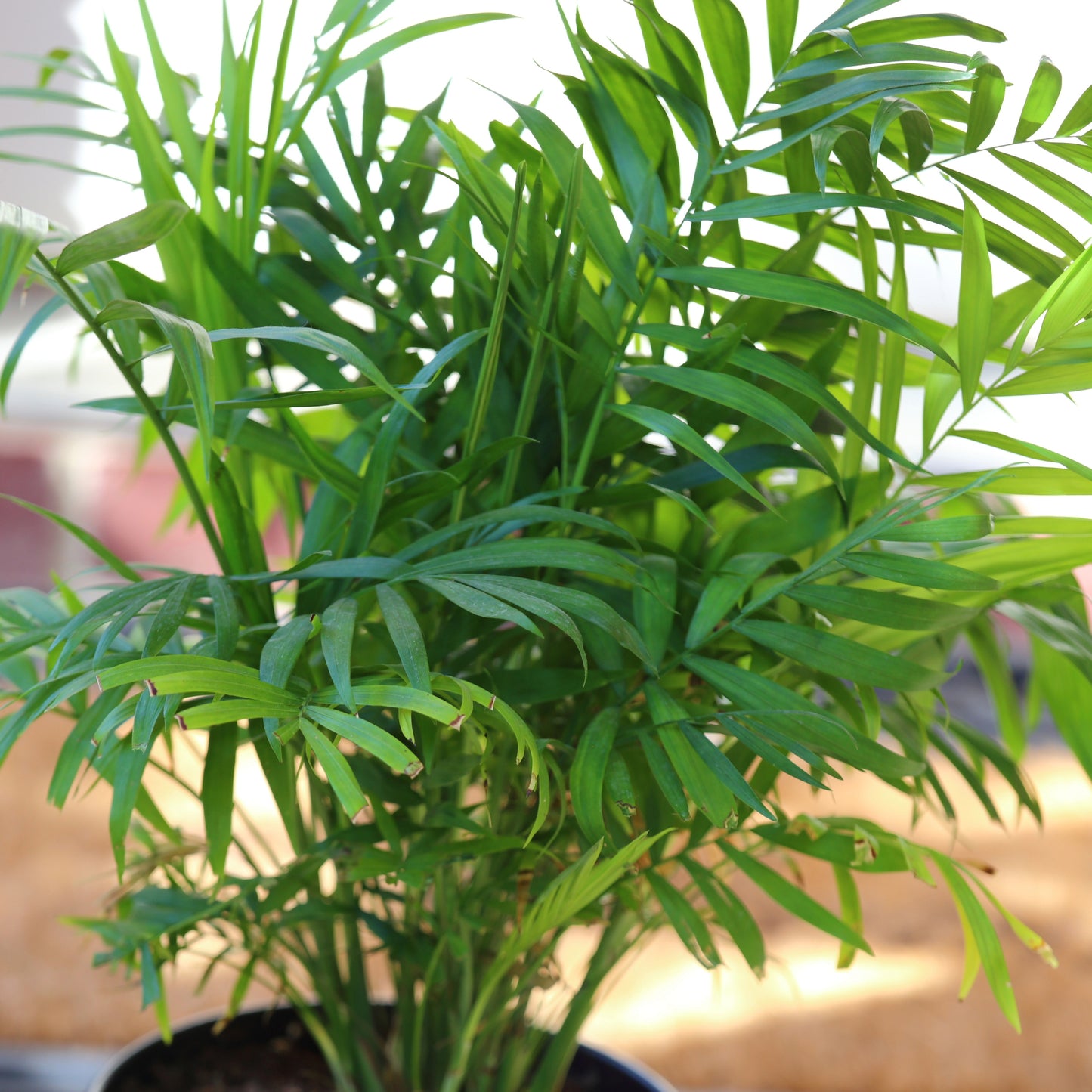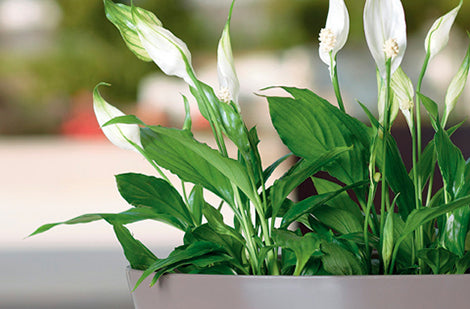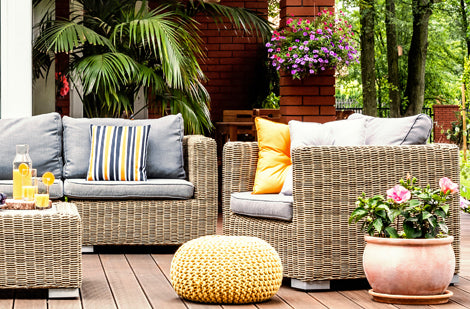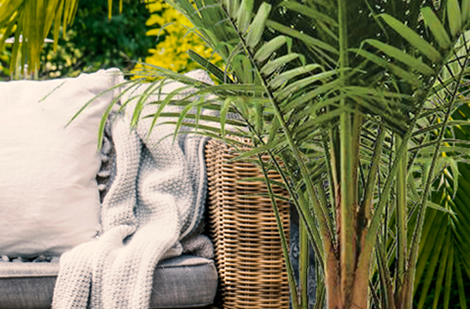Chamaedorea cataractarum
Chamaedorea cataractarum – Cat Palm (Cascade Palm)
Chamaedorea cataractarum – Cat Palm (Cascade Palm)
Exposure
- Bright indirect light
- Medium light
Rusticity
- Clumping palm, non-toxic
- Graceful foliage, arching habit
- Purifies ambient air
- Tolerates low light levels
- Loves high humidity
Chamaedorea cataractarum, commonly known as the Cat Palm or Cascade Palm, is a clumping palm highly valued for its dense foliage and graceful habit. Its fountain-like growth is particularly attractive for creating a tropical atmosphere in homes or offices. Being non-toxic to pets and humans and helping to purify the air, it is an ideal and safe choice for any living space.
Characteristics
- Foliage: The evergreen fronds are long, reaching up to 90 cm (3 ft), and elegantly arched. They are a deep green and composed of multiple narrow, lance-shaped leaflets, giving the plant a very full and soft-to-the-touch appearance, unlike other palms with rigid leaves.
- Flowering: Although grown for its foliage, it can produce small, inconspicuous cream-coloured flowers. However, flowering is very rare in indoor conditions.
- Light: It prefers bright but indirect light. It is also quite tolerant of lower light levels, making it an excellent choice for less sunny rooms. Absolutely avoid direct sun, which will burn its leaves.
- Habit: It grows in a dense clump, with multiple slender stems emerging directly from the base. This arrangement gives it a bushy habit and a very characteristic arched form, resembling a fountain of greenery.
- Growth: Slow. Indoors, it typically reaches a height of 1.2 to 1.8 metres (4-6 feet).
- Humidity: This palm loves ambient humidity. Misting it regularly, using a humidifier, or placing its pot on a tray of pebbles and water is very beneficial. Brown leaf tips are often a sign of dry air.
- Soil: Use a well-draining houseplant potting mix, ideally a formula for palms. Adding organic matter like peat moss helps retain necessary moisture while ensuring good drainage.
- Temperature: Maintain room temperatures between 18°C and 27°C (65°F-80°F). It must be protected from cold drafts, heating vents, and sudden temperature changes.
- Watering: The soil should be kept consistently moist, but never soggy. Water thoroughly when the top inch of soil (2-3 cm) feels dry to the touch. It does not like to dry out completely.
- Pests: Fairly resistant, however, it can be susceptible to spider mites if the air is too dry, as well as mealybugs and scale insects.
Uses
- Types of Use: It is an excellent houseplant grown in a container. Its moderate size and dense habit make it perfect for filling a corner, living room, or office.
- Ornamental Features: Its soft habit and arched fronds soften the corners of a room and instantly create a natural and tropical atmosphere.
- Summer Outdoors: This palm greatly benefits from a stay outdoors during the summer (mid-June to late August). It must be gradually acclimatized and placed in a shady or partly shaded spot, sheltered from direct sun and strong winds.
Care
- Fertilizing: Fertilize once a month from spring to fall with a balanced, water-soluble liquid fertilizer. Reduce or stop fertilizing in winter.
- Pruning: Pruning is minimal. Simply trim any yellowing or damaged fronds at their base to maintain a neat appearance.
- Repotting: Repotting is only necessary every 2-3 years, when the plant becomes root-bound. Choose a pot that is one size larger and carry out the operation in the spring to minimize stress.
Plant details
Dimensions
Dimensions
Characteristics
Characteristics
Habit:
Flowering colours:
Plant needs
Plant needs
Watering:
- Tolerates moist soil
Maintenance:
- Easy
- Fertilize regularly
Soil requirement:
Features
Features
Resistance:
Attract:
Use:
Attribute:
- Evergreen
- Non-Toxic to Cats
- Non-Toxic to Dogs



Related articles
-

Potting House Plants: which pot to choose
Read the articleBien qu'une plante puisse passer plusieurs mois et parfois même plusieurs années dans le même pot, avec le temps ses racines envahissent tout l'espace disponible. Il devient important de choisir...
-

Moving Up a Level: Advanced Guide to Repotting ...
Read the articlePropagate your violets! Discover the simple cutting method, the secret to the perfect soil mix, and how to fight mealybugs.
-

The Complete Guide to Buying and Caring for Ind...
Read the articleBringing a touch of nature to your home with plants is a great idea! Not only do they beautify your living space, but they also help purify the air. However,...
-

Build Your Own Terrarium: The Complete, Easy Gu...
Read the articleThe terrarium is the perfect addition to your decor! Learn how to easily create your own miniature garden with our complete guide.
-

Create a garden with succulents
Read the articleLes plantes grasses n’ont pas leur pareil pour créer des arrangements à la fois impressionnants par leurs couleurs, leurs formes et leurs textures et faciles à entretenir. Qu’on les agence...
-

Houseplants to discover - Butterfly Palm or Are...
Read the articleDypsis lutescens, anciennement Chrysalidocarpus lutescens
-

Calathea: The Essential Guide to Mastering the ...
Read the articleCalathea is a stunning addition, but it's demanding! The key to its success? Humidity. Find out why tap water and dry air are its worst enemies and how to give...
-

Jade Plant (Crassula): The Easy-Care Succulent ...
Read the articleThe jade plant is a must-have! Learn all the secrets to caring for this resilient succulent that naturally grows into an elegant miniature tree.
-

Madagascar Dragon Tree: Embrace Effortless, Gra...
Read the articleAdd a modern touch to your home! The Madagascar Dragon Tree is low-maintenance, perfect for beginners, and stands out with its slender look and two-toned foliage.
-

Aspidistra: The "Cast Iron Plant" Indestructibl...
Read the articleDon't have a green thumb? The Cast Iron Plant is for you! Tolerant of shade and missed waterings, it's perfect for lobbies and offices. Learn how to maintain its leathery...
-

Embrace the Fern: The Champion of Shade and Tro...
Read the articleGot a dark corner? Ferns are your allies! They are easy to care for if you master one factor: humidity. Learn how to water them perfectly for spectacular and full...
-

-

Kalanchoe: The Secret to Massive Blooms That La...
Read the articleNeed lasting colour? The Kalanchoe blooms profusely for over two months! An easy succulent that tolerates neglect and adds a vibrant touch to your home.
-

Snake Plant: The Unkillable Houseplant, Perfect...
Read the articleThe Snake Plant is an ideal houseplant for everyone, whether you're a beginner or an experienced gardener. Its resilience, ease of maintenance, and decorative appearance make it an essential choice...
-

Edible Flowers: Top 5 for Garden and Kitchen
Read the articleOffrant une belle gamme de couleurs, de formes et de textures, les fleurs comestibles enthousiasment les amoureux de jardinage et de cuisine.
-

Tropical Flowering Plants: A touch of the exoti...
Read the articleLes plantes tropicales à fleurs ont tout pour faire tourner les têtes! Colorées, odorantes, généreuses, elles n’ont pas leur pareil pour égayer une aide de repos, un balcon, une terrasse....
-

Keep a palm tree on the terrace - why not!
Read the articleDifficile de résister à l’appel des tropiques quand le soleil et les températures clémentes se pointent le bout du nez. Rien de mieux qu’un palmier sur la terrasse ou le...
-

Bring Your Plants Indoors for Winter: The Compl...
Read the articleDon't get caught by the first frost! Prepare your outdoor plants for winter with our complete guide.
-

When and how to repot house plants
Read the articleAlthough a plant can spend several months and sometimes even several years in the same pot, over time its roots invade all the available space.
-

Choosing the best potting soil for your indoor ...
Read the articleDon't let your plants stall: learn how to choose the ideal potting mix and optimize drainage for vibrant foliage.




























